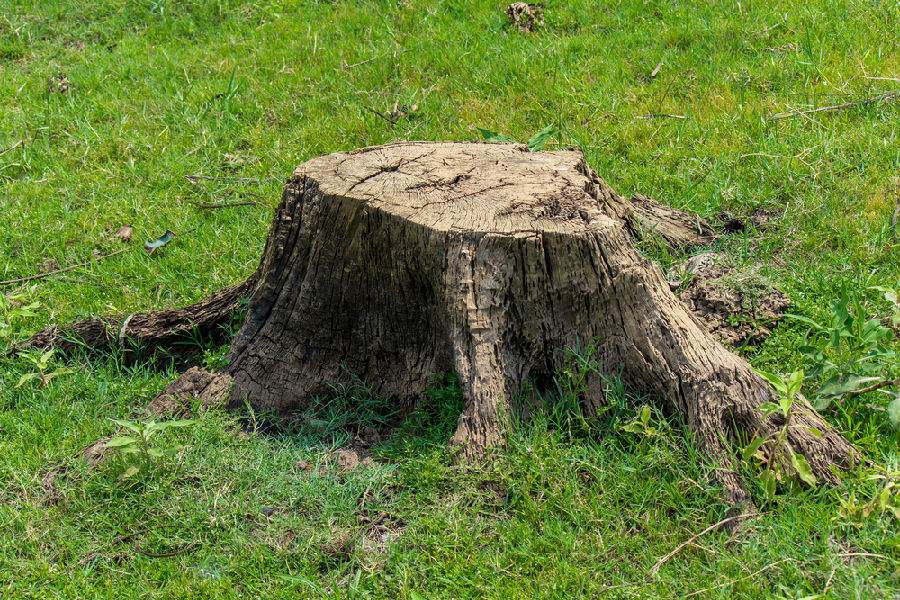(单词翻译:单击)
听力文本
And now the VOA Learning English program, Words and Their Stories.
Every word has its own story. What does it mean? Where did it come from? And how did it get into our language?
There are many stories of early settlers of America: the people who moved westward and opened up new territory. Many of these settlers were farmers who wanted a new home, a piece of land, some crops and cattle.
So, they moved west, cutting their way through difficult terrain, searching for a good place to live and farm. When they found it, they took out their axes and cut down trees. This was hard work. One of the hardest tasks was pulling up tree stumps from the ground.
And that's our word today -- "stump."

A tree stump is the part of a tree that remains in the ground after the tree is cut down. Stumps can also be the part of something such as a pencil that remains after the rest has been worn away.
Tree stumps gave these early American farmers big problems. Some stumps were so big that farmers had to use two or three horses to pull them out.
Stumps became part of life and part of the language. If someone asked a settler if they had cleared the land, they might answer: "Nope. I'm still stumped." This means they did not know how to get rid of the tree stumps from the ground.
And today, this meaning of the word is the same. To be stumped is to not know what to do or say. You are confused. You are blocked.
During the early days of America, the trees fell fast. The stumps remained for years. Sometimes they became part of the landscape. Some writers even wrote stories about tree stumps.
One day in 1716, a visitor named Ann Maury left the east coast to visit a so-called "stump town" in the west.
"I went into the middle of the town," she wrote. "And there, right in the center, surrounded by wooden buildings, was the great stump of a tree. I asked why this stump had not been pulled up. 'Oh, we just never thought of it,' was the answer. 'Besides,' the townspeople explained, 'whenever one of the two chiefs has something to say, he stands upon this stump and is raised higher than the others. In this way, he can be heard better.'"
When George Washington became commander of all the colonial troops in 1775, he supposedly used stumps to talk to his troops.
In time, anyone who stood on a stump and spoke to the people became a "stump speaker." As we know, politicians like to speak to crowds. So, it wasn't long before "stump" entered politics.
Presidential candidates travel all over the country to explain their positions on issues to voters and try to win their support.
Jon Favreau was a speechwriter for President Barack Obama. He explained in an ABC news video that a stump speech is a candidate's "argument" for why he or she should be elected.
The speechwriter says that stump speeches contain everything a voter needs to know about where a candidate stands on issues important to that campaign.
He says that stump speeches are useful "campaign tools that they (politicians) can use on the road." They can simply reuse the same speech over and over or change it a little to fit each audience.
We also use "stump" as a verb. The Online Etymology Dictionary defines "stump" as to "go on a speaking tour during a political campaign." The site says that usage began in 1838.
These days, politicians are "stumping" when they go into their same old speech that they have given over and over and over again. So, it is no surprise that "stumping" used this way is often not a good thing.
And that is the end of Words and Their Stories. If this story has left you feeling stumped, write us a comment. We will help you figure it out!
I'm Anna Matteo.
重点解析
1.open up 打开;开发;开始;展示,揭露
As the market opens up, I think people are going to be able to spend more money on consumer goods.
随着市场的开放,我想人们将能够花更多的钱购置消费品。
2.cut through 穿过;直通式;穿透
As a ray of light passes near the earth, it must cut through the atmosphere, which might bend the ray through the refraction of light.
作为光辐射通过接近地球时,它必须穿过大气层,它可能通过折射光而导致光线弯曲。
3.pull up 拔起;使······停下
Don't pull up to the door, though, I'll get out around the corner.
尽管这样,请不要把门拉开,我会在转弯处出来的。
4.figure out 估计;解决;了解;确定
This will enable you to figure out how much you need for your secured car loan.
这将使你多少你需要弄清楚你汽车贷款担保。
参考译文
这里是VOA学英语《词汇掌故》节目。
每个单词都有自己的故事。它是什么意思?出自哪里?怎样进入日常交际语的?
有很多关于美国早期移民的故事:人们向西迁移,然后发现了新大陆。这些移民中很多都是农民,他们想要一个新的家,一块土地,一些庄稼和一些牲畜。
所以,他们向西迁徙,穿过困难地带,寻找一个好的地方居住,耕作。当找到以后,他们拿出斧头砍倒树木。这是一项重活。最艰巨的任务之一就是从地面上拉起树桩。
这就是我们今天的单词——“stump”。
树桩(tree stump)是树被砍掉以后剩在地面上的那部分。“stumps(残端)”也可以指事物的某部分,如铅笔用完剩下的部分。
树桩给这些早期移民带来了大麻烦。有些树桩大到必须用两到三匹马才能把它拔出来。
“stumps”逐渐融为生活和语言的一部分。如果有人问一个移民他们是否清理好了土地,他们也许会回答:“还没有,我被树桩难住了。”这句话的意思是他们不晓得怎样清除掉地面的树桩。
今天,这个单词的意思还是一样的。“be stumped”意思是不知道做什么或者说什么。你很困惑,思绪堵塞了。
在美国早期,树很快就倒了。树桩却数年还在。有时候它们成了景色的一部分。一些作家甚至写就和树桩有关的故事。
1716年的一天,访客安·莫里离开了东海岸前往西边一个所谓的“树墩城”。
“我走进市中心,”她写道。“就在市中心,周围都是木制建筑,中间是一个很大的树桩。我问为什么这个树桩还没被拔走。‘哦,我们就没想过,’他答道。‘而且,’这个市民解释道,‘不论两个首领中谁有话说,他都可以站在这个树桩上,那他就比其他人高了。这样他的声音就能听得更清楚。’”
当乔治·华盛顿在1775年成为所有殖民部队的指挥官时,据说他是站在树桩上和部队交谈的。
最后,站在树桩上和人说话的人被称为“政治演说家(stump speaker)”。我们知道,政治家喜欢和群众说话。所以,不久“stump”就流入了政界。
总统候选人周游全国阐述和选民相关问题他们的观点,以争取选民们的支持。
乔·费夫洛是总统奥巴马的撰稿人。他在美国广播公司(ABC)的新闻视频中解释说,竞选演说是候选人陈述选民要投票给自己的“论据”。
这位撰稿人说竞选演说包含所有选民应该了解到的关于候选人对于竞选重要问题的观点。
他说,竞选演说是有用的“竞选工具,他们(政治家)在途中可以用到”。他们可以简单重复利用相同的演说或者简单改动下来迎合每位听众。
“stump”也可以作动词使。网上词源词典给“stump”的定义是“在政治竞选中进行巡回演讲”。这个网站称这种用法源自1838年。
如今,当政治家们一遍又一遍地重复自己老掉牙的演讲,他们就是在做巡回演讲(stumping)。所以,“stumping”在这种情况下通常不是什么褒义的用法也就不足为怪了。
这就是今天的《词汇掌故》。如果这个故事让你产生了困惑,在评论区告诉我们吧。我们会帮你弄明白滴!
我是安娜·马特奥。


